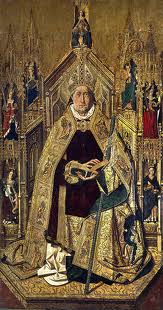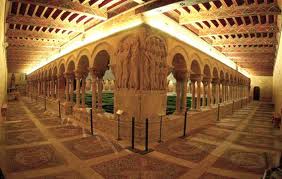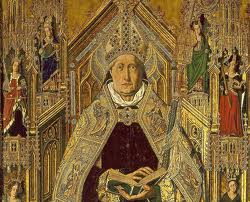Santo Domingo de Silos
'Santo Domingo de Silos', the full name of which is 'Santo Domingo de Silos entronizado como obispo' (Saint Domingo de Silos enthroned as a Bishop), was painted by the Gothic and Early Renaissance Spanish painter, Bartolomé Bermejo between the years of 1474 and 1477. It is the most well known painting by Bermejo and one of the most impressive paintings from the Spanish Gothic period.
The Painting

'Santo Domingo de Silos' was originally painted as the central painting of the main altarpiece at Church of Santo Domingo in Daroca in the region of Aragon. The painting was painted using oil paints on a wooden background and it measures 2.42 metres by 1.3 metres.
The painting is in the form of a pyramid, with Santo Domingo sat on a throne in the centre of the piece, occupying the majority of the space. The figure of Santo Domingo is sat facing the audience directly and appears very grand yet very solemn and rigid.
Surrounding the throne of the saint are images of the Seven Virtues which are housed by carved frames resembling columns. The Virtues are painted in rich colours and are also very realistic. The Virtues present include three theological Virtues: Faith, Hope and Charity. The other four Virtues are cardinal Virtues: Justice, Fortitude, Wisdom and Temperance.
The saint's face is very realistic. Bartolomé Bermejo employed the use of light and shadow in order to create this effect. The light also helps give definition to the body of Santo Domingo. The Realist technique used by Bermejo in this painting is very similar to the technique being used and taught by the Flemish School of painting. Bermejo was in fact famous for using Flemish elements in his work.

Santo Domingo is dressed as a Bishop in lavish clothes which were enhanced further still by Bermejo by using gold leaf to colour the painting. Gold leaf was used significantly during the medieval age in Spain and so Bermejo is clearly trying to echo the Byzantine masters of art by using this material.
The robes of Santo Domingo are also painted extremely realistically. In particular, the folds in the material at the bottom of the painting are a very detailed and accurate representation. The saint is also wearing a Bishop's mitre which has been painted with great detail, showing the small precious stones that decorate the hat. Resting in the crook of Santo Domingo's left arm is a Bishop's staff, called a crosier. Meanwhile the saint is holding an open Bible between his hands.
The painting 'Santo Domingo de Silos' demonstrates the supreme skill of Bermejo, particularly with the use of oil paints. Furthermore, it highlights the Flemish techniques for which Bermejo was famous. However, there are also some elements of this painting which show the differences between Bermejo's painting and true Flemish painters. For example, Bermejo employs much darker colours compared to his Flemish counterparts. He also tended to paint much larger paintings, such as 'Santo Domingo de Silos', compared with the smaller paintings of the Flemish artists.
History

We know that the painting 'Santo Domingo de Silos' was commissioned on the 5th of September 1474 as the contract for this work still exists. The piece was commissioned by the Church of Santo Domingo in Daroca and it was to be used as the main altarpiece in that church. From this information, it is believed that this painting is one of Bermejo's oldest known works.
Although Bartolomé Bermejo was the painter who completed the central artwork, some of the surrounding paintings, including those of the seven Virtues, were most likely to have been painted by his disciple, Martín Bernat.
Today, Bartolomé Bermejo's painting, 'Santo Domingo de Silos', can be found in the Museo del Prado (Prado Museum) in the Spanish capital of Madrid. The painting has been in the museum's collection since 1920.
